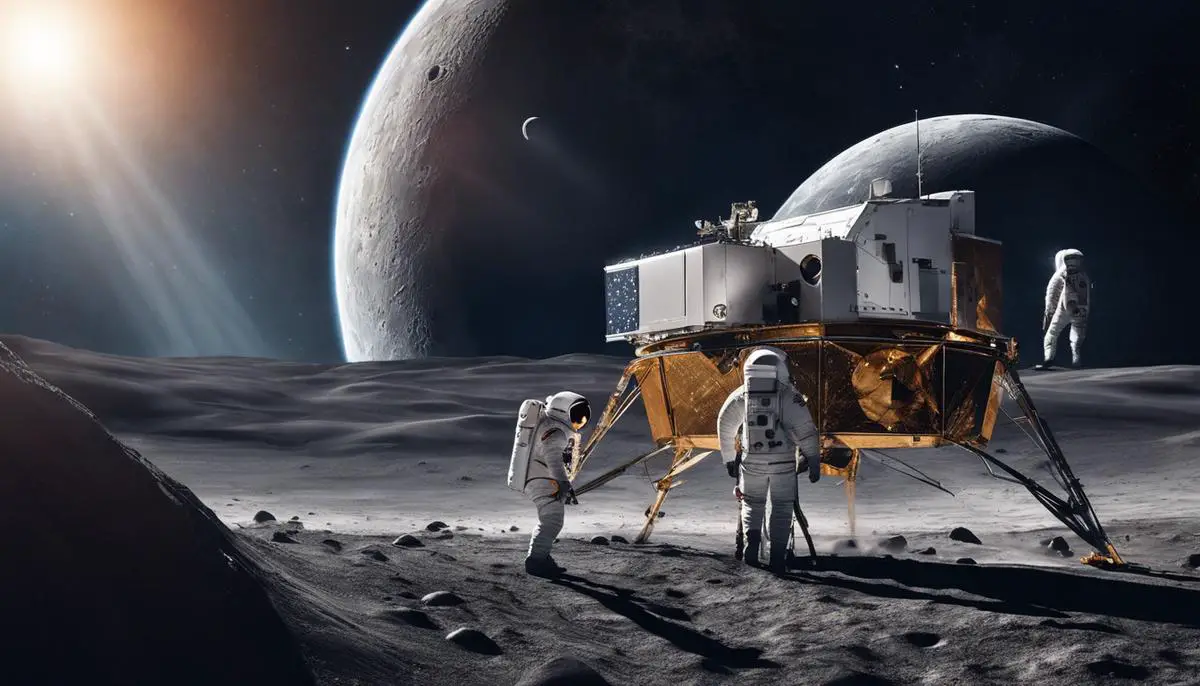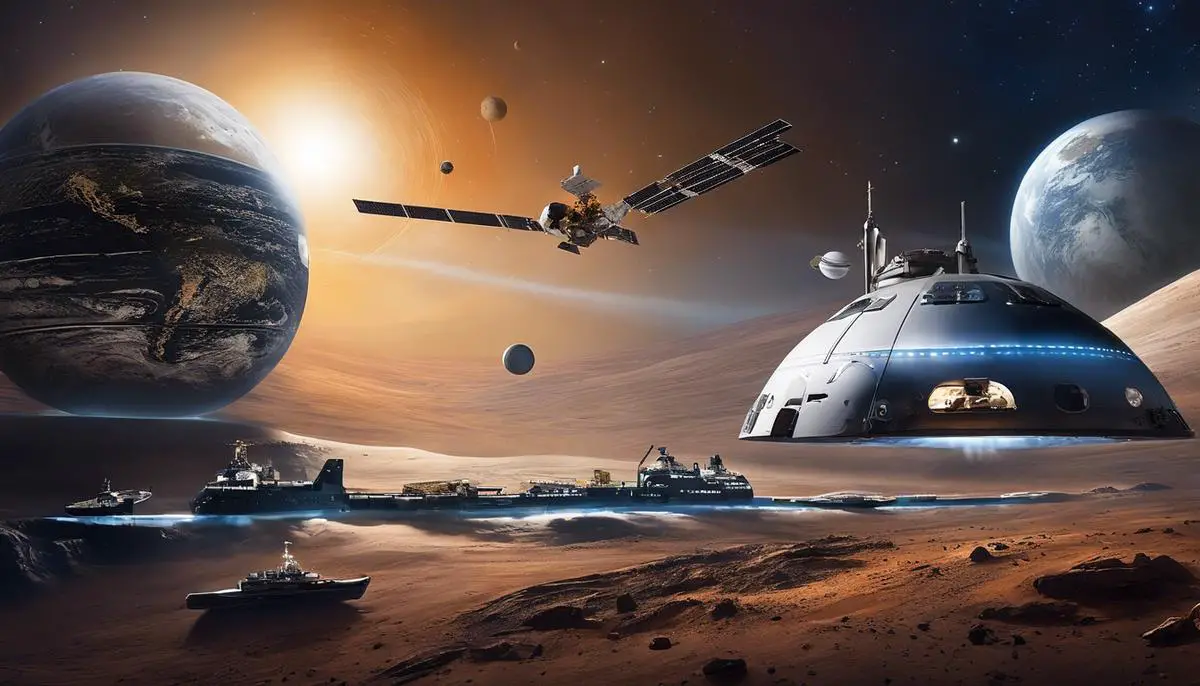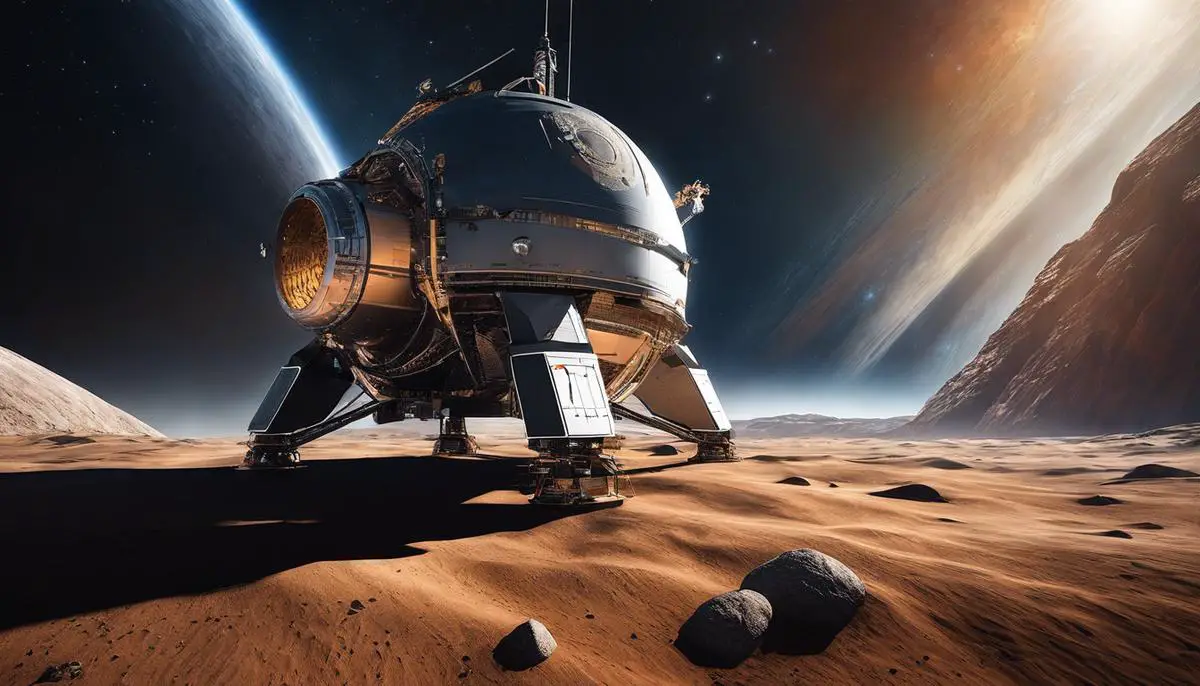Humanity has always held a fascination for the Moon, our nearest celestial neighbor. As we set our sights on not only returning but also establishing a sustainable presence there, the Artemis mission is the torchbearer for this new era of lunar exploration. Broadly conceived and unprecedented in its ambition, Artemis offers much more than just a revisit to the Moon. It symbolizes the confluence of pioneering science, cutting-edge technology, innovative partnerships, and a redefined vision for human space exploration. This mission aims to achieve both scientific and technological milestones with an underlying goal to prepare humanity for its next giant leap – Mars and beyond.
Contents
The Genesis and Goals of Artemis Mission
The genesis of NASA’s Artemis program can be traced back to the evergreen legacy of human exploration, the ancient urge to journey into new realms, and the undying spirit of fortitude that proffers uncharted discovery paths. Remember, the eons-old five-year journey of Odysseus sparked the christening of NASA’s this pursuance. Notably, Artemis, in Greek mythology, represents his twin sister, Apollo’s incarnation, thereby connecting to NASA’s Apollo mission that glimmered hope across the American conscience and writ global history. Artemis, symbolizing the goddess of Moon, succinctly exemplifies NASA’s ambitious endeavor to reconquer the lunar surface. The overarching objectives of this mission go beyond mere lunar exploration.
Under exquisite international collaborations and industrial amalgamations, the Artemis program endeavors to establish a sustainable human and robotic presence on the Moon, hence extending human pursuits beyond Earth. Abrupt space explorations and short-term human habitation is a milestone already achieved in NASA’s half-century-long astronautics history. The Artemis mission embodies a resolution to culturalize and habitualize space as the next arena for human expansion.
The quest to discover and invent is the undercurrent that drives scientific pathways. The Artemis program aims to set pace into this pursuit by catering as a stepping stone to further missions, like the red planet Mars. The program is set to explore and utilize the scientific, commercial, and societal potential offered by the mesmerizing lunar surface.
The lunar South Pole, being a reservoir of featured rich environments and untouched locales, offers the Artemis mission an unparalleled opportunity to develop new technologies, hone operational techniques, and enhance human survival in the spheres of space. Items on agenda include excavation of lunar regolith or surface soil, locating water ice, detailed lunar surface mapping, instituting in-depth exploration of solar and cosmic phenomena, and invariably, paving ways for commercial partnerships for future space tourism.
Progressive missions under Artemis aim to achieve infrastructural development leading up to a secured future space habitat by creating hospitable space environment and overcoming the daunting challenges posed by space flight. The idyllic objectives of Artemis breach the barriers of known exploration and promise to transfigure various multifaceted aspects of human life that once existed only in the realm of fantastical fiction.
Imbued with the peace emblem that NASA stands for, the Artemis program strongly propagates peaceful uses of space technology, adheres to a transparency value in research information sharing, and is deeply committed to the non-military nature of their explorations. These reflect the ceremonious blend of humanistic vision and scientific inventiveness harmoniously thriving in NASA’s ethos.
In summary, the Artemis mission is not just a mission for America; it is a genuine global mission. It heralds the dawn of a new era, where space ceases to be the frontier, but a new home for endless human potential and innovative aspirations that would certainly transcend the captivating blue dot we call home.

The Role of Artemis in the Context of Lunar Science
Expanding upon the seminal territory of lunar science, the Artemis mission aims to further deepen our understanding of these celestial phenomena, whilst broadening our scientific perspective in unparalleled ways. With a tenacious drive towards discovering the heart of the moon’s mysteries, the Artemis mission is set to challenge, enhance, and fortify the corpus of lunar science on several fundamental levels.
Firstly, this ambitious endeavor, spearheaded by NASA, aspires to provide substantive insight concerning the moon’s geologic history. Novel data generated by unprecedented exploration to the lunar South Pole is expected to yield a trove of geological information, thus augmenting our understanding of both lunar and Earth geology, and assisting in piecing together the evolutionary jigsaw of our solar system.
Interdisciplinary scientists anticipate elucidating inquiries surrounding the actual age of the moon. Unresolved questions regarding the moon’s early magma ocean, the lunar mantle, and the timeline of basin-forming impacts hinge on the procurement and precise dating of new rock samples. These inquiries, while challenging, are critical to refining models of early lunar history and planetary differentiation, which impact our wider understanding of solar system evolution.
Secondly, Artemis aims to enable opaque regions of the lunar environment to reveal their secrets. Known as Permanently Shadowed Regions (PSRs), these areas, uninterrupted by the sun’s wavelengths, are expected to hold water-ice. Studying these shadows will potentially revolutionize our understanding of how and where water is stored on airless bodies across our solar system. Moreover, these icy realms may serve as stepping stones to human habitats and provide resources for further space exploration.
Furthermore, the Artemis mission also fosters an understanding of the fundamental processes shaping the moon’s surface. One such captivating area is the study of space weathering. The untouched lunar surface, with its pristine record of cosmic radiation, micrometeorite strikes, and particles from the solar wind, yields indispensable information concerning space weathering process on airless bodies. This knowledge could be critical in planning future spacecraft designs and formulating mission strategies.
Lastly, the Artemis mission, with its persistent pursuit of lunar advancement, seeks to propel and ameliorate our comprehension pertaining to the lunar exosphere. The extremely thin lunar atmosphere, composed mainly of surface-released radon, helium, and hydrogen, needs cohesive data for comprehensive understanding. Comparison of Artemis data with previous mission findings could reveal changes in the lunar exosphere over time, reflecting influences of solar activity and meteorite impacts.
The Artemis mission, in essence, promises to revolutionize our understanding of the moon, and by extension, our place in the grand theatre of cosmos. It extends the comprehensive etch of lunar science from its current impressively broad basis, unveiling the in-depth understanding of planetary processes, the existence and dynamics of volatiles within shadowed lunar regions, the interpretive history of the moon’s geology, and the subtle nuances of space weathering. In its determined advancement, Artemis bears humanity forward on the path of persistent discovery.

Technological Innovations and Challenges of Artemis
The Artemis mission, an ambitious endeavor by NASA, is set to pave the path for humankind’s return to the moon. It has ignited a firestorm of innovation, presenting immense technological advancements coupled with complex challenges – a testament to how much space exploration has grown since we first ventured to the lunar surface.
One of the crowning technological achievements of the Artemis program is the Space Launch System (SLS). As the most powerful rocket that NASA has ever constructed, the SLS is crucial for launching astronauts aboard the Orion spacecraft to the moon. Its heavy-lift capabilities, efficient fuel usage, and versatile design make it an engineering marvel of our era. Yet, building such a behemoth hasn’t been without its trials, including unexpected delays and cost overruns.
The state-of-the-art Orion spacecraft, designed to carry a crew of four astronauts on extended missions, employs robust safety systems and advanced technologies for reentry, parachuting, and landing to safely shuttle astronauts back to Earth. Crafting a lightweight, safe, and self-sustaining habitable spacecraft capable of long-duration missions required overcoming arduous design and technological challenges such as radiation shielding, thermal management, and resource recycling.
The Artemis program also signals the advent of human-robot partnerships in space explorations. The VIPER (Volatiles Investigating Polar Exploration Rover) mission aims to map the moon’s water ice before human arrival – a crucial task requiring cutting-edge robotics and sensing instruments. It embodies the challenge of navigating an extraterrestrial terrain, whilst dealing with signal delays and limited power availability.
The Artemis Base Camp, planned as a long-term outpost on the moon, reinforces the necessity of sustainable, off-Earth living. This involves the development of advances in power systems to withstand the lunar night, reliable life support systems, and innovative technologies for in-situ resource utilization. Turning these visions into reality marks a decisive advancement in technology, yet it is by no means a small feat.
While the advancements involved in the Artemis mission are truly awe-inspiring, the program also grapples with intrinsic hurdles. The moon’s hostile environment exposes equipment and astronauts to extreme temperatures, micrometeoroids, and harmful space radiation. Meanwhile, the moon’s low-gravity environment warrants unique considerations for vehicle design, equipment handling, and astronaut health.
Moreover, the remote and harsh setting of the lunar surface compounds the challenge of system reliability. Any failure could have dire consequences, emphasizing the need for robust systems, exhaustive simulation testing, and contingency planning. As the Artemis program edges closer to its target launch dates, these technological challenges stand both as obstacles and catalysts for innovation.
The Artemis mission, seated at the confluence of ambition and possibility, encapsulates humanity’s relentless pursuit of knowledge and exploration. Through the lens of the Artemis program, it is clear that while the path to the moon brims with challenges, each one surmounted carves the path for awe-inspiring innovation and discovery. As Artemis takes shape, our perception of the moon as an unreachable relic of space will transform into a tangible chapter of human exploration, turning the once distant lunar landscape into the next frontier for human habitation and discovery.

Roles of International and Commercial Partnerships
The advancement of the Artemis program is underpinned by international partnerships and commercial collaborations.
A wealth of countries have declared their interest in participating in the Artemis mission to not only expedite lunar explorations, but also contribute significantly to its success.
NASA notes that in the same way ships were essential for explorations centuries ago, modern cooperation and shared infrastructure in space will pave the way for the future of human space travel.
Several international scientific and research institutions, governments, and companies are currently engaged in these collaborative ventures.
The Artemis Accords builds the relationships needed to formulate a peaceful community beyond the Earth’s atmosphere.
To this end, NASA, the European Space Agency (ESA), the Russian space agency Roscosmos, the Japan Aerospace Exploration Agency (JAXA), and the Canadian Space Agency (CSA), among others, have teamed up under the Artemis program.
Commercial partnerships, on the other hand, have a significant role in the Artemis program.
Collaborations with private enterprise have presented innovative approaches and cost-effective solutions to some of the challenging problems faced in space exploration.
Such relationships have manifold implications, extending from supply chain management, technical support to fueling the competitive industry that propels further innovation.
Entities such as SpaceX, Blue Origin, and Dynetics have been instrumental in developing the Human Landing Systems (HLS) for landing astronauts on the lunar surface.
Boeing and Northrop Grumman, for instance, have made remarkable strides in the launch and propulsion systems.
These collaborations liberate NASA to focus on mission-specific components and rely on the commercial sector for lunar landers, lunar gateway components, and support systems.
CCDev program serves as a noteworthy example of how NASA is increasingly relying on the private sector.
This program facilitates the development of crewed spacecraft to reach the International Space Station (ISS).
Commercial Lunar Payload Services (CLPS) are dedicated to delivering science and technology payloads to the lunar surface, enabling NASA to probe even before human arrival.
International and commercial collaborations are not simply beneficial, but essential to ensure the success of the Artemis missions.
They offer the distribution of resources, knowledge sharing, innovation acceleration, and broaden the reach of the mission.
The primary goal remains the successful human return to the moon’s surface, but the reverberations of this collaboration will impact future ambitions of extraterrestrial expedition.

Implications of Artemis for Future Space Exploration
As we delve deeper into the discussion on the Artemis mission, it’s vital to perceive the broader canvas upon which this cosmic sculpture of mankind’s reach into the universe is being endlessly sketched.
The threads of this narrative are woven not only around technicalities and celestial landscapes but also around the multilateral partnerships that glue together this global endeavor.
Reflecting on our earlier discourse, international collaboration holds significant weight.
Leading space agencies like NASA, ESA, Roscosmos, JAXA, and CSA are no longer ensnared in localized ambitions but are part of a global feat.
The Artemis Accords, a beacon of peaceful cooperation, create the framework for an inclusive and harmonious space community.
Parallelly, the role of the private sector in the Artemis missions has surged from commercial partnerships to mainstream contributors.
Prominent names in the aerospace industry such as SpaceX, Blue Origin, Dynetics, along with Boeing and Northrop Grumman, are jointly architecting the future.
Beyond the sphere of launch and propulsion systems, these enterprises are set to shoulder significant responsibilities, from developing Human Landing Systems to crafting lunar gateway components and crafting sophisticated support systems.
Historically, NASA’s Commercial Crew Development program (CCDev) and Commercial Lunar Payload Services (CLPS) have created the blueprint for fruitful private-sector integration.
Artemis program further strengthens the symbiotic public-private liaison, fostering an ecosystem that thrives on competition, driving innovation, and consequently reducing costs.
The exchange of intellectual resources and knowledge sharing becomes a natural progression in this scenario.
These shared endeavors not only speed up innovation but also solidify the bond amongst nations, fostering a sense of unity.
Moreover, by linking commercial objectives with scientific achievements, the Artemis mission bridges an age-old gap while making space exploration sustainable and economically feasible.
At its core, the Artemis mission is burning the trail for an era of exploration unfettered by earthly limitations.
Today, the lunar surface fosters our curiosity, tomorrow it may be Mars, and thereafter, who knows?
The stars that have fueled our imagination from time immemorial are no longer out of reach.
The Artemis mission is but the early chapter of an epic masterpiece where man, machine, and the cosmos come together.
To conclude this exploratory journey, let’s ponder the Artemis mission not in isolation, but as a stepping stone marking mankind’s progression toward unraveling the enigmatic cosmos.

The Artemis mission indeed carries the weight of humanity’s dreams and challenges towards a new era of space exploration. Through technological accomplishments, scientific novelty, and global partnerships, it brings us one step closer to realizing our cosmic potentials. This outreach beyond our home planet will not just enrich our understanding of the universe but will also drive innovations, inspire generations, and reinforce our place in the cosmos. Thus, as we stand at the threshold of this next stage of human space exploration, we can look forward to Artemis illuminating the path, pushing boundaries, and setting precedents for the future of mankind’s interstellar forays.
